
John Ueland

Audio By Carbonatix
Awards season for the film industry is at a fever pitch, but the buzz is just beginning for what some call the “Oscars of the food world” – the James Beard Foundation Awards.
Next month, the New York-based Beard Foundation will publish its much-awaited list of semifinalists for its 10 regional “Best Chef” awards, as well as national honors like Outstanding Restaurant and Outstanding Beverage Program.
The most closely watched award category by far is “Best Chef,” which is the highest prize for individual culinary achievement in the United States.
The last Phoenix-area chef to win the “Best Chef – Southwest” prize was Nobuo Fukuda in 2007. If no Phoenix chef wins the award this spring, it will mark a full decade since the Foundation honored a local chef with its highest prize.
Will you step up to support New Times this year?
At New Times, we’re small and scrappy — and we make the most of every dollar from our supporters. Right now, we’re $17,250 away from reaching our December 31 goal of $30,000. If you’ve ever learned something new, stayed informed, or felt more connected because of New Times, now’s the time to give back.
For close observers of the local food scene, Phoenix’s poor recent showing at the Beard Awards reflects the city’s low overall standing on the national food and drink scene.
“I don’t know why [Phoenix] doesn’t get much buzz on a national level,” says Andrew Knowlton, the longtime deputy and restaurant editor of Bon Appetit, one of the oldest food and drink magazines published in the U.S.
Knowlton is the chief architect of the magazine’s influential annual 50 Best New Restaurants list.
The magazine’s 50 nominees are gradually whittled down to a list of 10, known as the “Hot 10,” a sort of who’s-who of the independent restaurants making waves on the national food scene.
No Phoenix-area restaurants made Bon Appetit‘s top 50 list this year, nor did any last year, or the year before that. And no Arizona restaurant has ever made the Bon Appetit “Hot 10” list.
Knowlton is measured with his words and thoughtful with his assessment. But he’s honest about the fact that metro Phoenix has fallen off his radar lately.
“I don’t want to be the guy who’s saying what Phoenix needs to improve on … I’m not an expert on the area,” he says. “But at least from a national perspective, I haven’t seen the kind of growth, I would say, the creativity that at one point I expected to see out of the city.”
For many in the local food community, Knowlton’s assessment is fair, if a bit painful.
On the surface, metro Phoenix seems like it should have a thriving food and drink scene: It’s the sixth most populous city in the U.S., it has one of the fastest-growing dining sectors in the nation, and it’s been cited as one of the country’s next hot dining destinations by national outlets like the Huffington Post and Zagat. Yet the transition from up-and-coming food town to full-blown, nationally recognized food city remains elusive.
For many in the local food community, the main problem with Phoenix food is the city’s conservative dining culture, which has produced a market oversaturated with chain restaurants and familiar concepts.
But what exactly makes up a great, modern American food city? Most definitions include some of the following:
A great food city is one with maverick chefs that revel in creativity, and whose work is supported by the local dining public – a city where chefs and restaurateurs receive national press coverage and acclaim. It offers some kind of regional identity or flavors (usually in the form of a signature dish or two). It’s a city with purveyors and makers of high-quality ingredients and food products, a city that sets or influences national trends. It’s a city that boasts a healthy number of Beard Award winners, or one that at least remains actively competitive.
If these things represent the essential building blocks of a rich, vibrant dining scene, the verdict seems clear: Phoenix is not, at least not yet, a great food town.
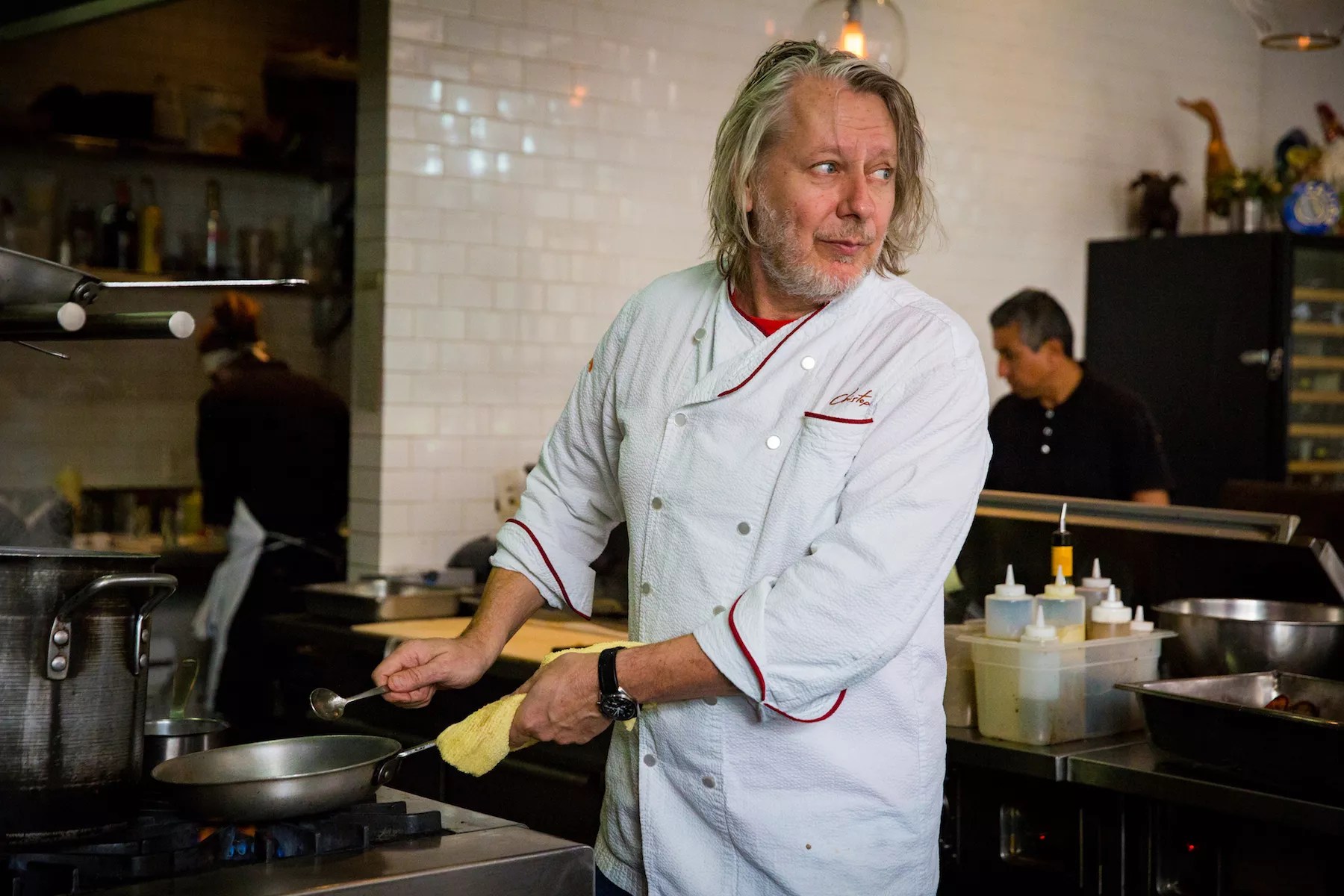
Christopher Gross, chef-owner of Christopher
Jacob Tyler Dunn
Andrew Knowlton says he remembers a period not too long ago, when it seemed that something interesting was happening in Phoenix.
He remembers the buzz around Binkley’s Restaurant in Cave Creek, and the early years of the Pizzeria Bianco cult, when long lines were a common sight around Heritage Square. He remembers “falling in love” with Matt’s Big Breakfast.
“I thought [Phoenix] was on the cusp of something,” he says.
Today, he says, the city doesn’t seem to generate that same level of buzz.
If there is a recipe for building a great, modern-day American food city, a big part of it seems to be buzz, the widely held perception that there is something culinarily interesting happening in a city.
It’s tempting to dismiss something as nebulous as “buzz.” But it’s a force that can be instrumental in shaping a food scene – and people’s careers.
Christopher Gross, chef-owner of the French-inspired Christopher’s Restaurant & Crush Lounge at Biltmore Fashion Park, notes that landing national press can lead to bigger acclaim and recognition.
Gross is one of a handful of Beard Award-winning chefs currently working in metro Phoenix. He won the award in 1995. Many Phoenix chefs, including Nobuo Fukuda, Robert McGrath, and Alex Stratta, he notes, were featured in Food & Wine magazine’s annual “Best New Chefs” feature before going on to win the regional James Beard award.
“When you get that one, it brings you a lot of exposure,” says Gross. “And a lot of times, the next thing you know, you’re nominated for a James Beard Foundation award.”

Andrew Knowlton, deputy editor of Bon Appetit, says that a strong dining scene could be a boon to Phoenix tourism:
Courtesy of Andrew Knowlton
Lately, though, the Phoenix food scene has not gotten much play in national taste-making outlets like Food & Wine. And along with a dearth of national press, Phoenix also suffers from a lack of marquee-level destination restaurants – the kind of nationally recognized food and drink temples that bring distinction to a city, and help drive tourism.
One example of such a restaurant is Kai, the ultra-luxurious and uniquely Arizonan restaurant, tucked deep in the recesses of the Wild Horse Pass Resort just south of Phoenix. It’s currently the only AAA Five Diamond and Forbes Five Star restaurant in Arizona.
Metro Phoenix also doesn’t have an instantly recognizable signature dish, something many argue helps build a city’s culinary identity and gives it some bragging points – the proverbial Philly cheesesteak, Nashville hot chicken, or Charleston shrimp and grits.
There is the chimichanga, a midcentury Mexican-American dish that is quintessentially Arizonan. Tucson claims the dish as its own too, though, and neither side seems particularly invested in winning that battle.
Some argue that great food cities often set national trends, or at least help shape the national palate by exporting homegrown concepts.
Phoenix’s most successful exports – the city’s major contributions to the national food scene – include P.F. Chang’s and Fox Restaurant Concepts, both mega-successful restaurant groups headquartered in the Valley.
Both are wildly popular with consumers in Phoenix and beyond. Both offer pleasant yet formulaic dining experiences, sprung from templates designed to be replicated across various regions and cities. And both are known for strictly curated, stylish dining rooms, with menus designed to appeal to as many consumers as possible.
Neither group, though, is recognized for producing restaurants with the kind of attributes that tend to receive national acclaim – things like creative risk, local flavor, or independent vision. Neither feel innately local, either, and few argue that they give Phoenix much in the way of bragging rights.
For independent restaurants, meanwhile, there’s the central question of culinary creativity – the thing that keeps menus across the city from looking like rough facsimiles of one another.
If you study menus across Phoenix, for instance, how many offer something like a Brussels sprouts small plate, usually paired with bacon?
Knowlton says he’s had a hard time spotting a certain level of creativity on Phoenix-area menus.
“I’m not saying everything has to be weird and foamy,” he says. “I just see a lot of foods that I’ve already had around the country, and it seems like Phoenix would do itself some good as to kind of run with what it’s good at, and develop its own thing.”
Finally, it’s hard to dismiss the prestige that national acclaim and recognition bring to a city. Winning a Beard Award is not easy – critics of the prize contend that the foundation’s voting process is colored by politics and regional bias. But winning one, at the very least, would represent a significant groundswell of national support and recognition for work being done at the local level.
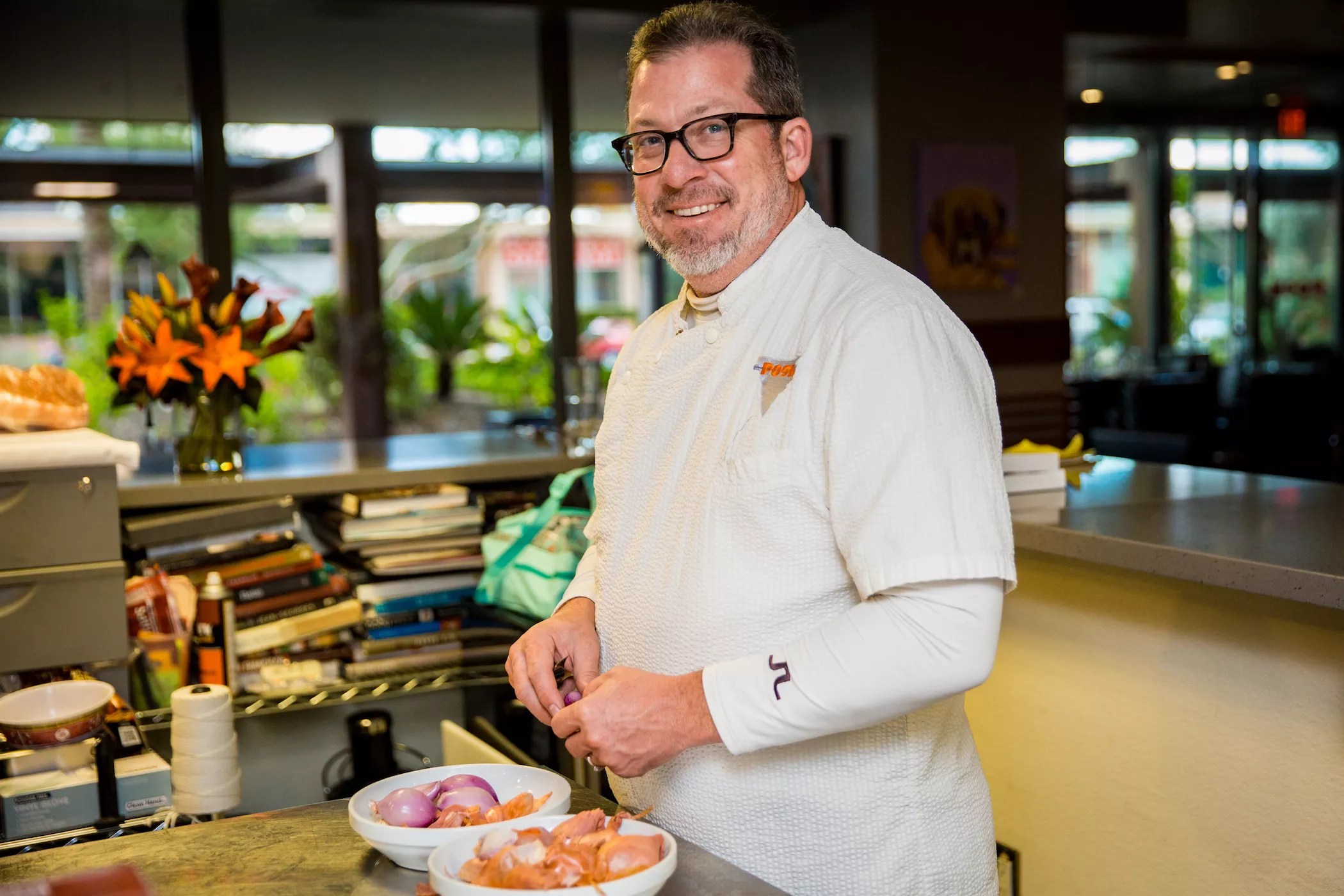
Josh Hebert, chef-owner of Scottsdale
Jacob Tyler Dunn
Historically, the food genres and dining formats that have found popularity in metro Phoenix are not the kind that win national accolades.
Many of the oldest and most beloved restaurants around town are steakhouses. Stockyards Restaurant, open since 1947, a byproduct of the old Tovrea Land and Cattle Company operation, is possibly the oldest steakhouse still operating in the Valley. And there is, of course, Durant’s, which opened in 1950, its midcentury mystique well preserved to this day.
The region’s upscale resorts – a major part of Phoenix life, culture, and commerce since the early 20th century – have also played a role in shaping the character of Phoenix dining. One of the Valley’s oldest restaurants is El Chorro Lodge in Paradise Valley, which opened in 1937. It’s not a resort restaurant, but its Southwestern design, upscale fare, social-club airs, and views of Camelback Mountain encapsulate the sort of high-end, tourist-friendly experience that is still a major force in local dining. That restaurant, though, has never been on the receiving end of much critical acclaim, and is probably best known for its sticky buns. And today, many proper resort restaurants have come to be understood as repositories of high-end but safe cooking.
Mexican food, of course, particularly the northern Mexican cooking traditions of Sonora, Sinaloa, and Chihuahua, has given Phoenix much of its culinary character, and helped spawn classic Phoenix-area restaurants like Carolina’s, Macayo’s, and Filiberto’s, not to mention countless modern renditions of carne asada.
And chile-blasted, New Mexico-style cooking has been part of the local culinary DNA for decades, a tradition preserved at local institutions like Los Dos Molinos and Richardson’s.
Most local Mexican restaurants are thought of as beloved purveyors of local “grub,” though, and not treated seriously enough to gain national critical attention.
There is also Southwestern food – Mexican food’s culinary cousin. “Southwestern” is mostly thought of as hokey these days, a genre of cooking so broad and undefinable that it’s mostly shorthand for something featuring corn and avocado, then dribbled with “zesty” sauce.
But it was the nouvelle Southwestern cuisine of the 1980s that brought Phoenix dining its first wave of national attention and acclaim.
In 1993, Vincent Guerithault of Vincent’s on Camelback, a French chef who garnered the world’s attention by fusing classic French technique with Southwestern flavors, was the first Phoenix chef to win a James Beard award.
During the 1990s, metro Phoenix began to shed its reputation as a city that was good for only steak and cheesy enchilada platters.
Restaurants like Rancho Pinot, which opened in 1993, brought elevated, seasonal American fare to the Valley. And it was during the ’90s and 2000s that Phoenix, of all places, began to earn a reputation as one of the best places in America for pizza.
Chris Bianco won the regional James Beard award in 2003 – the first pizzaiolo to ever win the prize.
In 2004, Ed Levine wrote in the New York Times that the Bronx transplant was making what might be “the best pizza in America” – and he was doing it in a city “with more golf courses than pizzerias.”
Pizzeria Bianco, possibly the only Phoenix restaurant to have its own, full-length Wikipedia entry, has helped shape and influence a whole generation of young American pizzaioli. And Bianco’s critical success has helped expand the definition of what kind of food an award-winning chef is allowed, or supposed, to make.
The rise of Pizzeria Bianco to the upper echelon of American food circles has helped usher in a modern dining era rich with Vera Pizza Napoletana-certified pizzerias, and wood-fired pizza in general.
There are now so many excellent wood-fired pizzerias around town, they must at least rival the number of golf courses in Phoenix.
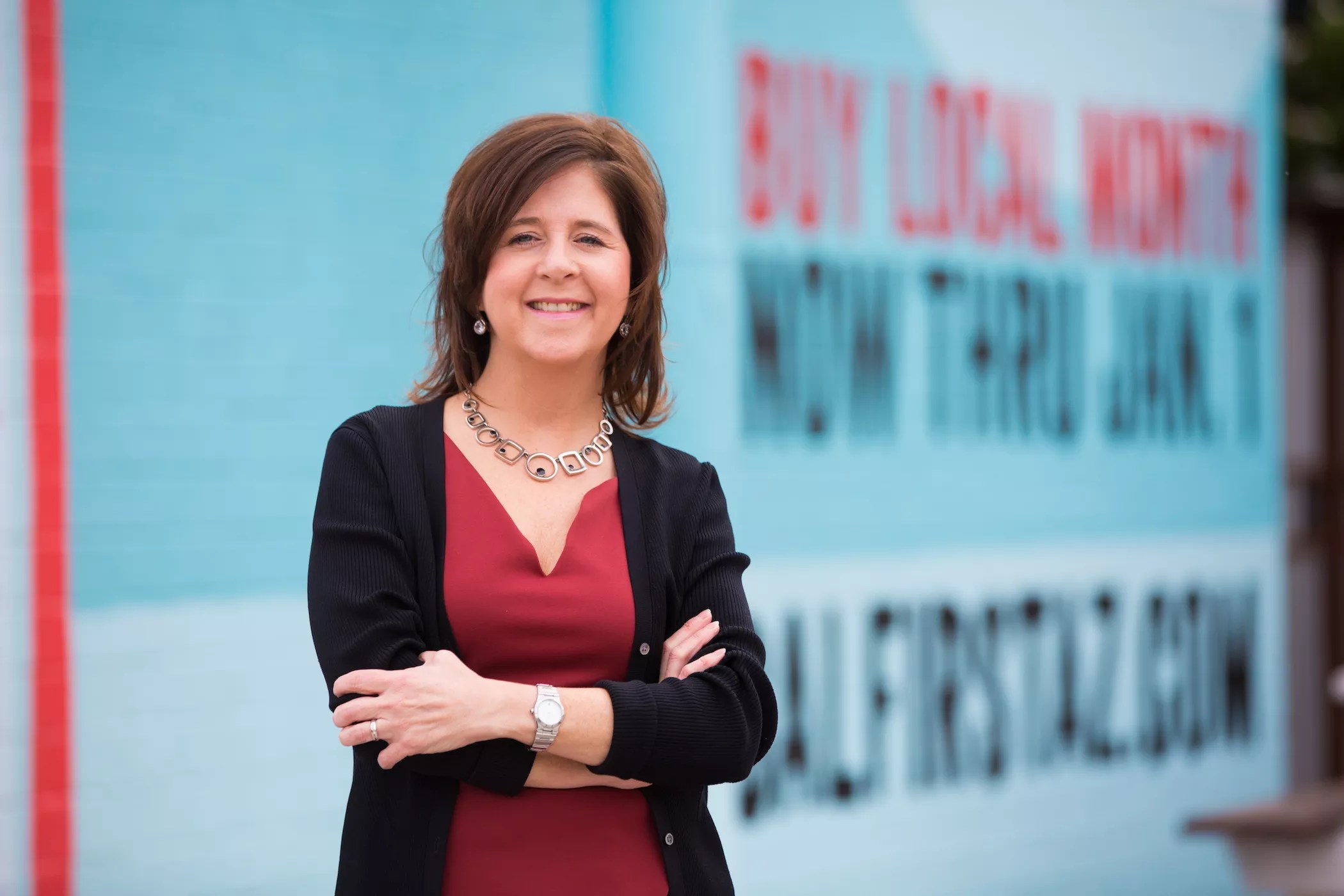
Kimber Lanning, the founder and executive director of Local First Arizona, believes Phoenix suffers from a public image problem that affects national coverage of the local food scene. National media is often
Jacob Tyler Dunn
Almost no one disputes the idea that Phoenix dining has come a long way in the last 20 years, or that the city ranks respectably well when you consider every major metropolitan area in the country.
But what’s keeping Phoenix from joining the ranks of top-tier, well-established “food towns”?
One of the biggest factors, according to many on the front lines of local dining, is Phoenix’s love for chain restaurants and familiar concepts, and not just those that were born here (like P.F. Chang’s).
Chain restaurants are not a trouble spot unique to the Phoenix dining scene, of course.
The chain restaurant concept took hold of the country in the 1980s, replacing a whole constellation of mom-and-pop restaurants and neighborhood eateries across America.
But chain restaurants really have a stranglehold on Phoenix.
Christopher Wolf of the Arizona Culinary Institute wonders if it has something to do with the high number of transplants in the Valley.
“We’re a broadly expanding metropolitan area and people like familiarity,” he says. “Unfortunately, it seems to be chain restaurants that pop up everywhere … When you come to a new area, you want something familiar.”
Familiar brands, imported from other cities, seem to do well in metro Phoenix.
One of the top stories from New Times‘ food and drink coverage in 2016 was about the opening of a Lou Malnati’s restaurant in Phoenix. The beloved Chicago-based deep-dish pizzeria chain opened its first location outside of greater Chicago in Phoenix’s Uptown Plaza last spring.
There’s a lot of nostalgia for Midwestern food in metro Phoenix, and nostalgia for other regions too (news about East Coast chains like Shake Shack and the Halal Guys opening here also generated high levels of interest last year). But is nostalgia for and devotion to the food of other cities a good thing for Phoenix’s food scene?
Others argue that Phoenix consumers tend to be conservative when it comes to where they spend their dining dollars.
The ubiquity of chain restaurants in metro Phoenix points to a certain level of “comfort zone” dining.
Bottom line, says chef Josh Hebert, a city’s food scene is shaped by what consumers want.
Among the local food-obsessed contingent, Hebert’s name comes up with frequency. Posh, his “choose your own adventure” fine-dining spot in Scottsdale, is where locals go to throw caution to the wind and feast on spontaneously devised, multicourse tasting menus.
What many Phoenix diners want is not really that complicated, says Hebert: “They want simple, they want straightforward, they don’t want fussy.”
If LA is the city of glitz and self-absorption, and New York is the city of hustle and ambition, then Phoenix, he says, is an easygoing, unpretentious city – a good place to settle down, live comfortably, and raise a family.
Hebert believes that easygoing attitude – and an appreciation for simple, unfussy, familiar food – is reflected in the city’s dining scene.
“This is not an environment that is rewarding innovation,” he says.
Eliot Wexler, the restaurateur whose Nocawich gourmet sandwich concept has a cult following around town (and whose former restaurant, Noca, received a Beard nomination for “Best New Restaurant” in 2009), says that if Phoenicians have a culinary Achilles heel, it is probably the white tablecloth steakhouse – especially in the vein of Houston’s, the tony steakhouse chain that is a part of the Hillstone Restaurant Group.
“Phoenix is addicted to Houston’s,” Wexler says. He admits that even he is not immune to the addiction.
“I eat there, and I love it – it’s probably the best-run chain in the country,” he says. “You go to a Houston’s in Phoenix, Atlanta, Washington D.C. – you’re getting the same meal. That’s really hard to do, and their service is great.”
But the chain’s popularity, he says, has created many Houston’s knock-offs in metro Phoenix. And diners’ devotion to the high-end steakhouse format has created a saturated market that threatens the existence of smaller, independently owned restaurants, says Wexler.
For Frank Schneider, currently the general manager at Nocawich, Phoenix’s lack of standing as a recognized food town overlaps with a larger national trend: the decline of traditional fine dining.
Schneider believes that steakhouses have largely taken the place of fine dining in metro Phoenix.
Schneider, who started his career as a busboy, eventually worked his way to becoming general manager at the storied Mary Elaine’s, back when the sumptuous restaurant at the Phoenician offered the most luxurious fine-dining experience in Arizona.
He says he noticed fine dining begin to dwindle sometime in the 2000s.
“The three-hour or four-hour dinner – nobody wants to do it anymore,” Schneider says. “People are looking for simpler products.”
Kimber Lanning, the founder and executive director of Local First Arizona, among numerous other endeavors, remains one of Phoenix’s biggest champions.
She believes Phoenix is exploding with culinary talent. But she wonders whether culinary invention is rewarded.
“Some of our best chefs, they have their wings clipped a little bit,” she says. “You’ve got this world-class chef in a restaurant with an audience that’s like, ‘Um, so do you have any paninis?'”
But Lanning believes that Phoenix’s lack of standing as a food town has more to do with public image.
Some of the legislation that has come out of Arizona in recent years, Lanning says, has “framed a lot of people’s perceptions of Phoenix.” The perception that Arizona is “anti-immigrant” and “anti-Latino” creates a lot of bad press for Phoenix.
And it’s not just outsiders with a negative outlook on Phoenix, she says.
“I believe Phoenicians still kind of have low self-esteem. We like to beat up on ourselves,” she says.
She points to Arizona’s burgeoning wine scene as an example of how locals sometimes have trouble acknowledging the good stuff happening around the state.
“We have almost a dozen wineries that are scoring a nine or above on Wine Spectator,” she says. Yet some local consumers, she says, still dismiss Arizona wine.
Another major stumbling block, she says: Arizona’s economic development teams, the groups that lobby to bring tech and other big companies to metro Phoenix.
Arizona is behind the curve when it comes to understanding the role that a robust dining scene can have in attracting business to the state, she says.
Many of the state’s economic development teams, Lanning says, are “busy talking about tax breaks.” But it rarely occurs to them to talk about the city’s food scene as a major selling point.
Developing a strong food scene, according to Lanning, is not just a matter of making Phoenix cooler, but a matter of economic survival.
“If you look at an educated workforce right now, they put nightlife and 24-7 access to international cuisine above things like safety, quite frankly,” Lanning says. “We need to be more responsive to what the work force wants, and I just don’t think we are right now.”
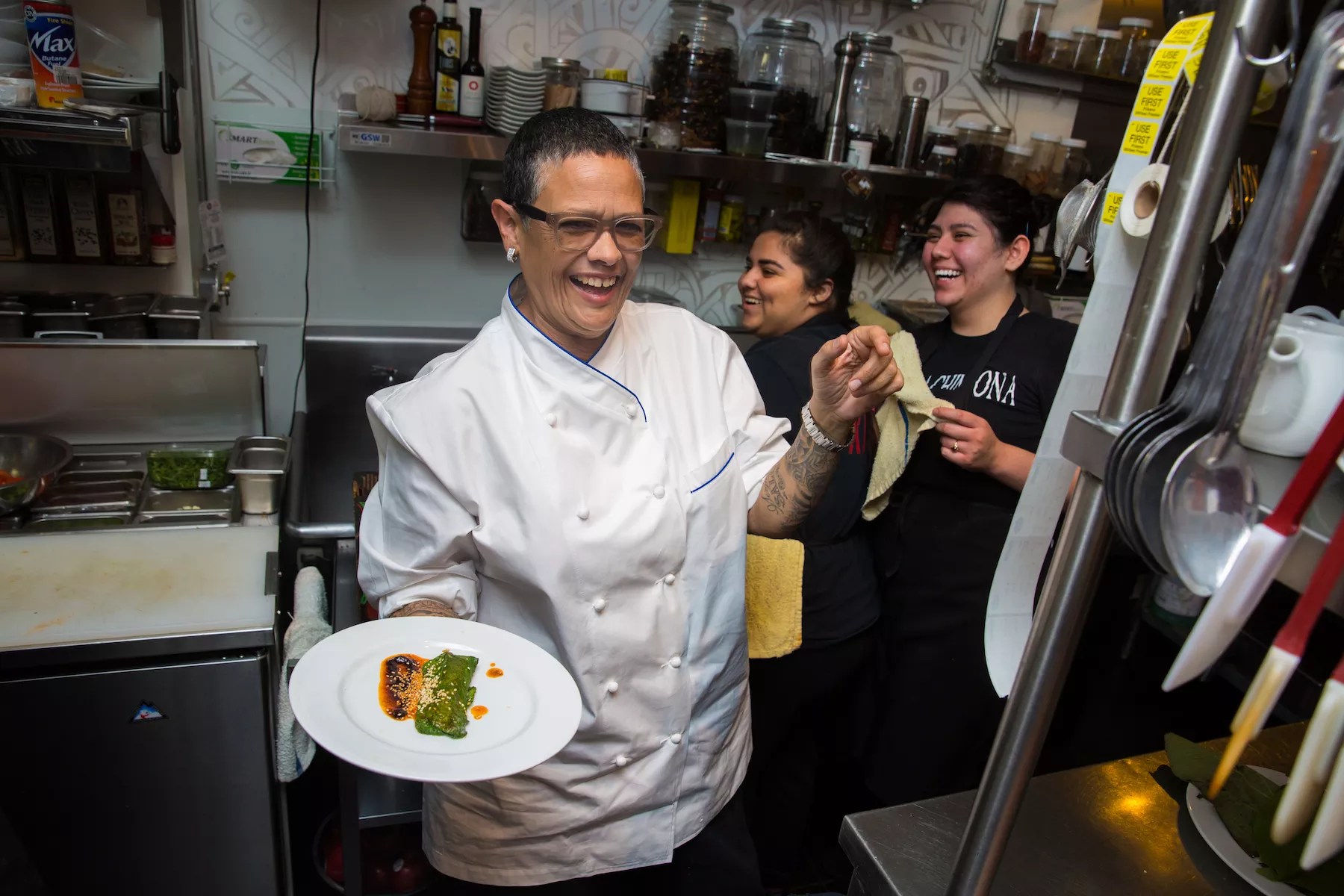
Chef Silvana Salcido Esparza, of Barrio Caf
Jacob Tyler Dunn
Phoenix doesn’t have the fine-dining pedigree of cities like San Francisco or New York – it doesn’t have any laurels to rest on.
The well-worn quotation, largely credited to Steve Martin – “Be so good they can’t ignore you” – seems sort of fitting for Phoenix, which is rarely exalted to the status of other major American cities, in the food realm or otherwise.
If Phoenix is to ever become widely understood as a modern, cosmopolitan food city, it will have to work doubly hard for that reputation.
Andrew Knowlton, the Bon Appetit editor, says he’s rooting for Phoenix. He thinks it will take homegrown talent to make Phoenix a great American food town – kids who grew up in Phoenix, understand Phoenix, and believe in their city.
Chef Silvana Salcido Esparza, for her part, is optimistic about Phoenix’s future as a top-tier food town.
Her newest restaurant, Barrio Café Gran Reserva, was just named to OpenTable’s “100 Best Restaurants in America for 2016,” one of only three Arizona restaurants to make the list.
She may not have a James Beard Award (for which she has been nominated four times), or a coveted spot on Bon Appetit’s Best New Restaurants list. But Salcido Esparza is content.
“What’s important to me is that we are on the radar of the people who are here to visit us and that we roll out the best motherfucking party for them – that’s what’s important to me,” she says.
Let’s not throw a pity party for Phoenix, the chef says.
“We have a lot of good chefs here.”
Salcido Esparza points to chef Kevin Binkley – who recently debuted a new version of his flagship fine-dining restaurant – as proof that exciting things are happening in Phoenix.
Most everyone around town, including Salcido Esparza, thinks that Binkley is a shoo-in, eventually, for the city’s next Beard award.
Christopher Wolf of the Arizona Culinary Institute, who has cooked alongside Binkley in the past, wonders if Phoenix has been keeping the prize just beyond his reach.
“Kevin Binkley is a raw, super-talented guy,” he says. “I’ve thought so many times that if you would transplant Kevin Binkley to a more foodie city, I bet he would have won that award already.”
Others wonder if his ambitious and pricey new restaurant concept can survive the Phoenix market.
Salcido Esparza, though, admires Binkley’s ambition: “He’s got an ‘I-don’t-give-a-shit’ attitude,” she says. “And I love it.”
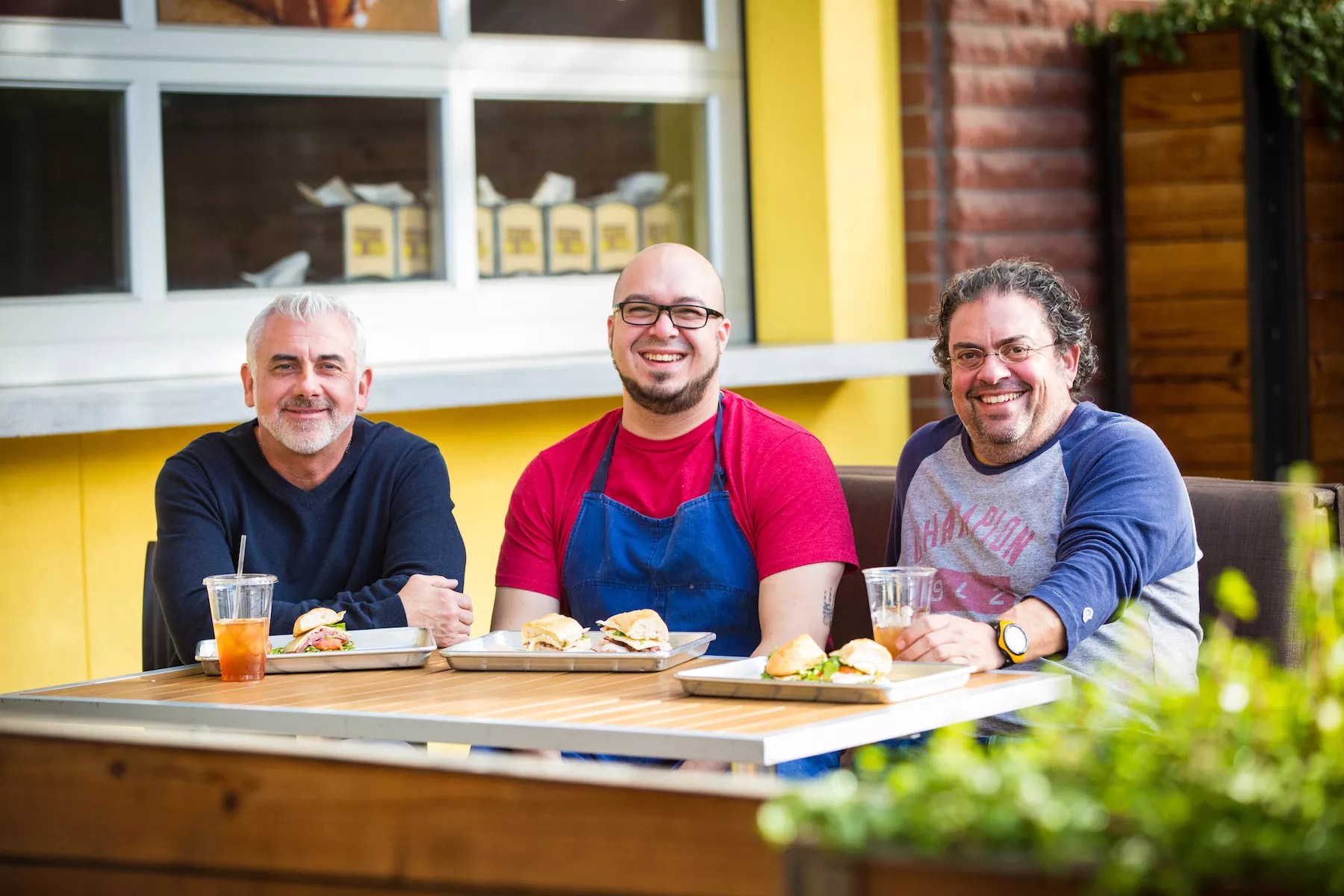
General manager Frank Schneider, chef Eric Abaloz, and owner Eliot Wexler of Nocawich, a local gourmet sandwich concept with three locations around the Valley.
Jacob Tyler Dunn
On a recent December evening, a couple dozen diners are gathered on the front patio of the new Binkley’s restaurant in midtown Phoenix.
Numbers come up a lot when Binkley’s comes up in conversation: $160 for about 22 courses, not counting the optional wine or cocktail pairings. It’s a three-hour dinner that sometimes stretches into almost four.
But none of the diners scattered around the alcoves and garden benches and fire pits in front of Binkley’s restaurant seem particularly focused on numbers. Most are chattering and sipping, enjoying the cocktails that were passed out around six o’clock.
A parade of amuse-bouches rolls out, the small bites appearing at well-paced intervals: a foie gras slider brightened with huckleberry jam. Tuna tartare kissed with wasabi. A pear butter vol-au-vent served with a chorizo chip. Baby radishes, basted with brown butter. A bacon doughnut with flakes of Parmesan cheese.
That’s just the first hour. Dinner moves inside. Dishes stream out of the open kitchen for about two more hours.
By the end of the night, the main dining room inside Binkley’s is filled with loose chatter, the sounds sort of melodious, swelling and falling. Many in the dining room look slightly worn down, but pleased. Nobody is complaining. Most linger in the room as the chef makes the rounds.
Nobody knows what’s going to happen to a place like Binkley’s in a city like Phoenix. But in this room, on this particular Thursday night in midtown, nobody seems to think that Phoenix is a bad place to have dinner.